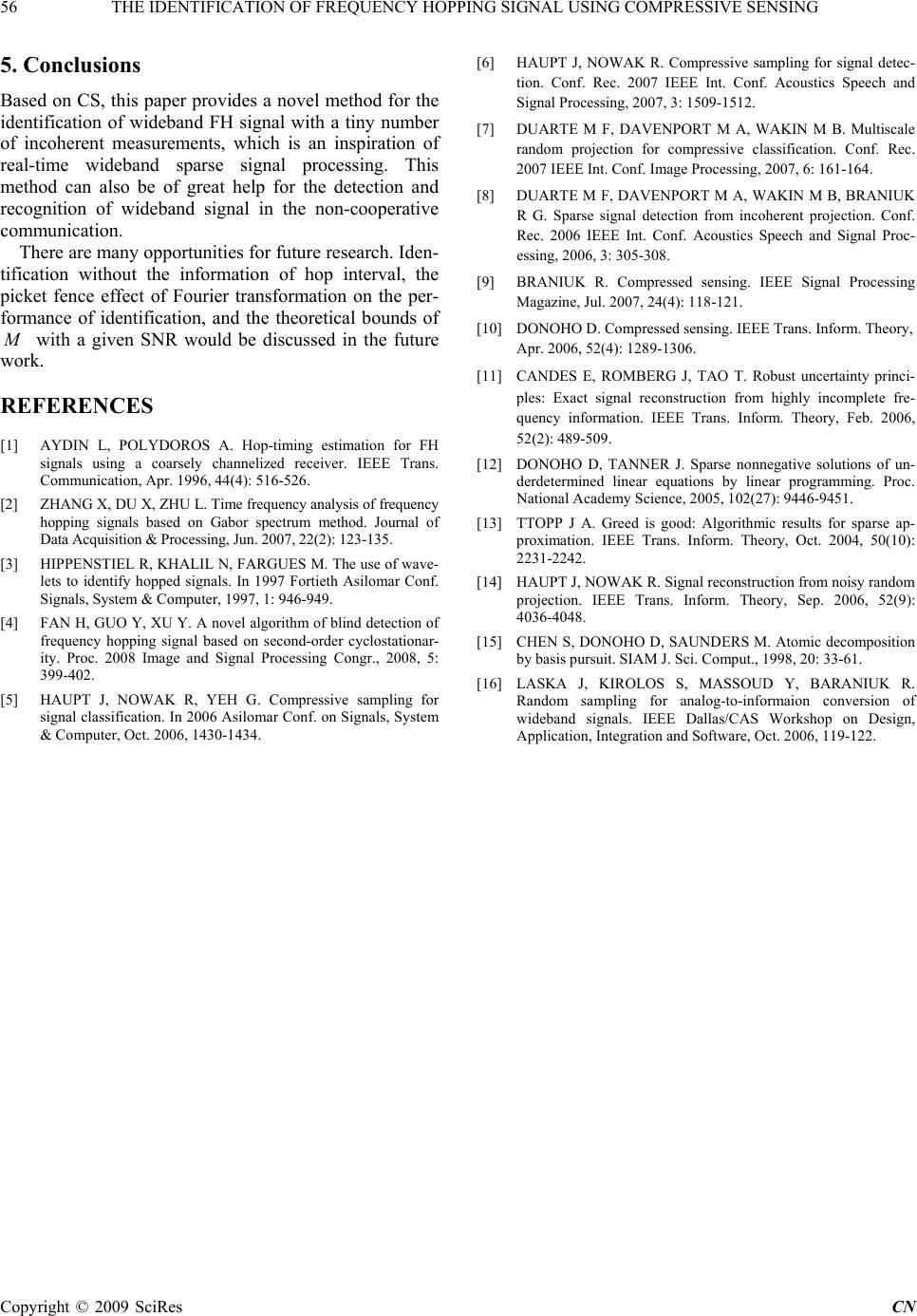
56 THE IDENTIFICATION OF FREQUENCY HOPPING SIGNAL USING COMPRESSIVE SENSING
Copyright © 2009 SciRes CN
5. Conclusions [6] HAUPT J, NOWAK R. Compressive sampling for signal detec-
tion. Conf. Rec. 2007 IEEE Int. Conf. Acoustics Speech and
Signal Processing, 2007, 3: 1509-1512.
Based on CS, this paper provides a novel method for the
identification of wideband FH signal with a tiny number
of incoherent measurements, which is an inspiration of
real-time wideband sparse signal processing. This
method can also be of great help for the detection and
recognition of wideband signal in the non-cooperative
communication.
[7] DUARTE M F, DAVENPORT M A, WAKIN M B. Multiscale
random projection for compressive classification. Conf. Rec.
2007 IEEE Int. Conf. Image Processing, 2007, 6: 161-164.
[8] DUARTE M F, DAVENPORT M A, WAKIN M B, BRANIUK
R G. Sparse signal detection from incoherent projection. Conf.
Rec. 2006 IEEE Int. Conf. Acoustics Speech and Signal Proc-
essing, 2006, 3: 305-308.
There are many opportunities for future research. Iden-
tification without the information of hop interval, the
picket fence effect of Fourier transformation on the per-
formance of identification, and the theoretical bounds of
with a given SNR would be discussed in the future
work.
[9] BRANIUK R. Compressed sensing. IEEE Signal Processing
Magazine, Jul. 2007, 24(4): 118-121.
[10] DONOHO D. Compressed sensing. IEEE Trans. Inform. Theory,
Apr. 2006, 52(4): 1289-1306.
[11] CANDES E, ROMBERG J, TAO T. Robust uncertainty princi-
ples: Exact signal reconstruction from highly incomplete fre-
quency information. IEEE Trans. Inform. Theory, Feb. 2006,
52(2): 489-509.
REFERENCES
[1] AYDIN L, POLYDOROS A. Hop-timing estimation for FH
signals using a coarsely channelized receiver. IEEE Trans.
Communication, Apr. 1996, 44(4): 516-526.
[12] DONOHO D, TANNER J. Sparse nonnegative solutions of un-
derdetermined linear equations by linear programming. Proc.
National Academy Science, 2005, 102(27): 9446-9451.
[2] ZHANG X, DU X, ZHU L. Time frequency analysis of frequency
hopping signals based on Gabor spectrum method. Journal of
Data Acquisition & Processing, Jun. 2007, 22(2): 123-135.
[13] TTOPP J A. Greed is good: Algorithmic results for sparse ap-
proximation. IEEE Trans. Inform. Theory, Oct. 2004, 50(10):
2231-2242.
[3] HIPPENSTIEL R, KHALIL N, FARGUES M. The use of wave-
lets to identify hopped signals. In 1997 Fortieth Asilomar Conf.
Signals, System & Computer, 1997, 1: 946-949.
[14] HAUPT J, NOWAK R. Signal reconstruction from noisy random
projection. IEEE Trans. Inform. Theory, Sep. 2006, 52(9):
4036-4048.
[4] FAN H, GUO Y, XU Y. A novel algorithm of blind detection of
frequency hopping signal based on second-order cyclostationar-
ity. Proc. 2008 Image and Signal Processing Congr., 2008, 5:
399-402.
[15] CHEN S, DONOHO D, SAUNDERS M. Atomic decomposition
by basis pursuit. SIAM J. Sci. Comput., 1998, 20: 33-61.
[16] LASKA J, KIROLOS S, MASSOUD Y, BARANIUK R.
Random sampling for analog-to-informaion conversion of
wideband signals. IEEE Dallas/CAS Workshop on Design,
Application, Integration and Software, Oct. 2006, 119-122.
[5] HAUPT J, NOWAK R, YEH G. Compressive sampling for
signal classification. In 2006 Asilomar Conf. on Signals, System
& Computer, Oct. 2006, 1430-1434.